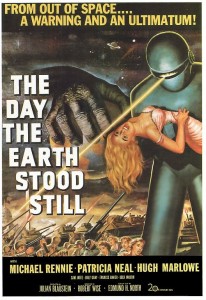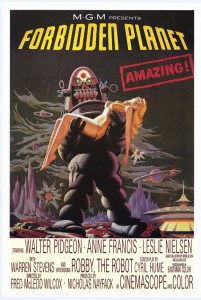 Last weekend I took a stroll down memory lane courtesy of a couple of special edition DVDs from my local library. I picked up copies of The Day the Earth Stood Still, and Forbidden Planet, two films that are presently in my library, but the two in my collection do not include the extra features on these special edition discs. With my wife shaking her head at my drooling fanboy reactions, I spent several hours over Friday, Saturday, and Sunday watching the features associated with these films, and learning more about them and coming to appreciate them even more in the process.
Last weekend I took a stroll down memory lane courtesy of a couple of special edition DVDs from my local library. I picked up copies of The Day the Earth Stood Still, and Forbidden Planet, two films that are presently in my library, but the two in my collection do not include the extra features on these special edition discs. With my wife shaking her head at my drooling fanboy reactions, I spent several hours over Friday, Saturday, and Sunday watching the features associated with these films, and learning more about them and coming to appreciate them even more in the process.
The first disc I put in my DVD player was the one that included the features associated with The Day the Earth Stood Still. These included a Making of The Day the Earth Stood Still, Decoding ‘Klaatu Barada Nikto”: Science Fiction as Metaphor, The Astounding Harry Bates, and The Mysterious, Melodious Theremin.
The second disc included special features associated with Forbidden Planet. Among these features I enjoyed Amazing! Exploring the Far Reaches of Forbidden Planet, the Turner Classic Movies original documentary Watch the Skies!: Science Fiction, the 1950s and Us, an entertaining collection of science fiction movie trailers, and Robby the Robot: Engineering a Sci-Fi Icon. (This last featurette included the work of Fred Barton, aka “The Robot-Man, who has established himself as an artist and technician in recreating custom made robots from various movies and television programs, including and especially Robby. See Barton’s website to learn more about this. If I had the disposable income Robby would be in my basement office as a part of my collection on the fantastic!)
 Bringing the features together for these two films made for an interesting process, and it was striking to see a few similarities between them.
Bringing the features together for these two films made for an interesting process, and it was striking to see a few similarities between them.
Both films differed from much of the science fiction of the 1950s in taking the subject matter perhaps a little more seriously than many of the cinematic offerings of the time. They offered intelligent screenplays that dealt with significant issues but in different ways. The Day the Earth Stood Still moved outward to address national and international issues related to post-war nuclear America during the Cold War in a standoff with the Soviet Union. By contrast Forbidden Planet moves in the opposite direction to raise issues related to the individual. Drawing upon the Freudian notion of the id, this film suggests that the real challenge may not be from aliens we encounter on other worlds, or even those who may come to us as alleged invaders, but rather the monster within ourselves that our increasingly sophisticated technology may empower with even more destructive ability.
Another similarity is the striking scores within each film. The Day the Earth Stood Still includes a score by the great Bernard Herrmann, who used two electronic instruments, theremins, to produce the eerie and alien sounding main element of the theme which has since become stereotypically associated with science fiction and alien films from this time period. One of the interesting features associated with the special edition of this film is a description of the theremin and how it works, and a demonstration of this process through a Main Title Performance by Peter Pringle. Forbidden Planet has an equally memorable score courtesy of the first completely electronic music (or “tonalities” as credited in the film) that at times also served a dual purpose not only as music but also as sound effects.
In my view these films not only hold up as great examples of science fiction from the classic period of this genre in cinema, but also raise questions with contemporary relevancy. While The Day the Earth Stood Still may be read as a film investing hope and possibility in the young United Nations of the time, in the intervening decades of UN scandal and lack of ability to enforce sanctions aimed at impeding nuclear proliferation, are we still a nation and a world threatening not only our own survival, but that of possible intergalactic neighbors as well? In light of Forbidden Planet‘s warning of our inner monstrousness, how do we proceed with caution so that new technologies are used to further the best of humanity rather than materializing our monsters of the id?
The Day the Earth Stood Still and Forbidden Planet are two classic science fiction films that provide us with challenge and fodder for reflection amidst the tales of giant, irradiated creatures from the 1950s. They’re worth looking at, and thinking about, again and again.





There are no responses yet